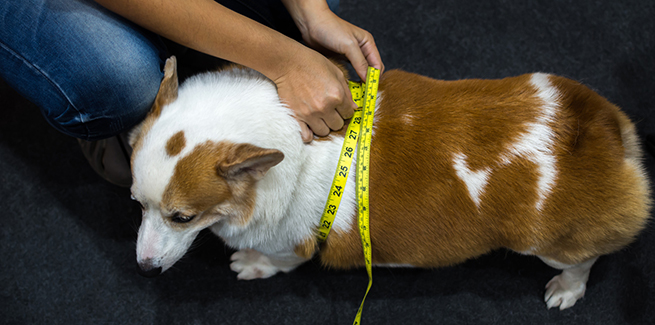Pet obesity: Is it a disease yet?

Because, according to Banfield Pet Hospital, it’s an epidemic.
That’s the conclusion Banfield Pet Hospital’s 2020 Veterinary Emerging Topics (VET) Report, which states that more than half of all adult dogs seen at Banfield’s more than 1,000 hospitals in 2018 were considered overweight or obese. In fact, the report states outright that obesity is an epidemic.
If it’s an epidemic, does that mean it’s a disease?
Not yet, says Ernie Ward, DVM, DVFT, but we’re working on it.
NEWStat Talked to Ward, an expert on pet obesity, founder of the Association for Pet Obesity Prevention (APOP), and a coauthor of the 2014 AAHA Weight Management Guidelines for Dogs and Cats to find out what’s going on.
Ward is lead author of APOP’s “Global Pet Obesity Initiative Position Statement”, which essentially calls for classifying pet obesity as a disease. That position was endorsed in June of 2018 by the AVMA Board of Directors, and AAHA endorsed it in April of that year.
They’re not alone.
Ward says 25 of the world’s largest veterinary organizations have endorsed the APOP initiative, which standardized the body condition score scales for pets, nailed down the definition of obesity, and classified it as a disease.
“Having said that, there still hasn’t been any formal action anywhere,” Ward added.
“I think that what’s really holding it back are the same challenges that the human medical profession faced when they took up this issue nearly a decade ago,” Ward says. Specifically, what ramifications does declaring pet obesity a disease have in terms of medical liability? And if it’s a disease, who’s going to pay for treatment?
Ward says another roadblock is that many veterinarians take a narrow view of obesity in pets: “[They] only see the environmental causes.” To many, Ward says, it’s a simple problem of overfeeding and lack of exercise. But Ward points out that many other issues are involved, such as genetics, medications, and other disease conditions that can lead to obesity, such as osteoarthritis.
“What we’ve seen in human medicine is that that declaration raises awareness in physicians, raises the seriousness, [and] the urgency of the discussion. It unlocked innovation.”
Ward believes innovation is vital to solving the problem of treating pet obesity.
“And we know that medical advice, talk therapy, [and] lifestyle medicine are ineffective. In studies of humans, people gain back all of the weight within five years [after] talk therapy.”
In 2013, when the American Medical Association declared obesity a disease in humans, Ward says, “There was an explosion of innovation,” both surgical and pharmacological. “That’s what excites me the most,” Ward says. “Right now, the only treatment we can offer in veterinary medicine is ‘feed less, exercise more.’”
“That’s why I’m so hopeful that the profession . . . will begin to take this more seriously,” says Ward. But despite the worldwide support for the APOP initiative, “there still seems to be trepidation around actually just declaring [pet obesity a disease].”
It may just be a matter of time.
“The AVMA has been very supportive of this initiative,” says Ward, but to really break the logjam, the AVMA’s House of Delegates would have to take it up and vote on it as a formal declaration. Then other veterinary organizations would likely follow. “I think it’s just a matter of going through the bureaucratic process,” Ward adds.
Ward concedes that viewing obesity as an issue that extends beyond the food bowl is a major mind shift for many veterinarians.
But once the profession makes that shift, Ward says, “It will unlock innovation. Once [we] say to the world, ‘[Obesity] is a disease that should be taken seriously and urgently by our profession,’ I think that’s going to drive some seriously creative people.”
“There’s so much capital and investment and expertise sitting on the sidelines just waiting to jump in. . . . once [pet obesity is] officially declared [a disease], we’re going to have some exciting solutions in the next three to five years,” Ward says.
“All of these industries are looking for that official endorsement that says this is a legitimate concern and we know now that the veterinary profession takes it seriously.”
Photo credit: © iStock/PongMoji



